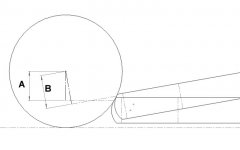To put draw on the cue you have to hit below center. In extreme examples, when shooting jacked up (or angled), your eyes may mislead you into thinking you are hitting the cue ball with the TOP part of the tip when you are actually hitting with the middle or bottom part. That is, when sighting, you think you are aiming correctly, but you end up hitting the cue ball with the middle or bottom part of the tip - which will result in less than favorable results. The trick is aiming a little "lower" than you think you should to get draw.seymore15074 said:A sighting problem?
As a technical matter, when viewing the cue ball from a jacked up position, take the plane intersecting the center of the cue ball. Striking the cue ball above this plane should result in using the bottom part of the tip (because both the tip and the cue ball are curved). The closer to the center plane you get, the closer to using the middle of the tip. And in general play, draw is achieved by hitting with the top of the tip's curved surface below the plane.
Below is a crude MS Paint picture with a more typical scenario. As you can see, sighting down an elevated cue can cause you to perceive that you are hitting lower then you really are. In fact, you might think you are contacting the cue ball in the same place as a level cue (red line), but you might actually be one tip or more above the level cue contact point. As a general proposition, shooting level allows you to hit lower on the cue ball. Sorry for the MS Paint rendition

